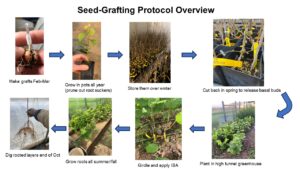Project Overview
Information Products
Commodities
- Nuts: hazelnuts
Practices
- Crop Production: grafting, high tunnels or hoop houses
- Education and Training: demonstration, extension, on-farm/ranch research, participatory research
Proposal summary:
Expanding hazelnut production in the Upper Midwest will
require greatly increasing the supply of the newly released UMHDI
1st Generation Selections. There are currently orders
for more than 40,000 plants and the TNC's EAP is likely to expand
that to 400k plants. Although nurseries are working to increase
supply through tissue culture and stem cuttings, it is important
that enterprising growers can produce their own plants using
relatively inexpensive propagation methods. This enables growers
to participate in the nursery industry and provide some income
while they wait for their own plants to mature and bear
nuts.
Unfortunately, hazelnuts are very difficult to propagate
vegetatively. They aren’t like currants or elderberry where you
can stick a hardwood stem in the ground and it grows. So far, the
nurseries haven’t had much success with softwood stem cuttings or
tissue culture, either. Instead, everyone has been relying
on the effective (but slow) mound-layering technique. The UMHDI
researchers have been successful recently with a relatively
low-tech method called seed-graft layering, but it has only been
done on a small proof-of-concept scale by Hausers. We propose to
test the method at scale and evaluate its effectiveness on all
the recently released UMHDI cultivars.
Project objectives from proposal:
 Agroforestry practices offer considerable benefits to
Agroforestry practices offer considerable benefits to
the land including providing habitat, holding soil in place, and
filtering water. Hazelnuts are viewed as a cornerstone species
for alley-cropping as they can provide a high-value crop AND all
the benefits of woody perennials.
The new cultivars from the UMHDI offer a great
opportunity and it is important that
enterprising farmers have the option and means necessary to make
their own plants. In cooperation with the UMHDI researchers, we
have been working on a low-tech seed-grafting method that is
capable of turning a 1-bud scion into three rooted layers in 2
years. It’s not a great multiplication rate, but it is better
than the traditional mound-layering system that can take 3-5
years to produce new plants. In year 1, we graft the bud on a
newly sprouted seed and grow the grafted plant in a greenhouse
all year. After over-wintering the plant, we cut it back to just
a few buds and plant it in a high tunnel greenhouse, where growth
rates are superior to outside the high tunnel. The plants
grow for roughly two months and produce 2-5 new shoots.
Around mid-June we layer those shoots in sawdust to produce
roots. By the end of October, we have field ready plants. A
diagram showing the process from the proof of concept trial is
attached.
Though the method has worked in small-scale
proof-of-concept trials, we now need to try it at scale on all
the UMHDI cultivars. This will allow us to determine with which
cultivars it works and to produce enterprise budgets to determine
costs of production.
Objective 1: Optimize the protocol for growing
seed-grafted plants in a greenhouse in year 1.
Objective 2: Evaluate the effectiveness of the high
tunnel layering system on the UMHDI hazelnut cultivars.
Objective 3: Record all cost inputs and rooted-layer
outputs to develop an enterprise budget for the system.
Objective 4: Share the results and enterprise budget at
the annual Upper Midwest Hazelnut Growers Conference in March
2025.
Mark Hamman at UMN and Midwest Hazelnuts, LLC will
produce 2000 grafts starting in February 2024. Those grafts will
include 300 each of the five recent UMHDI releases (Arb 7-1, Eric
4-21, Stap N7-6, Rose 9-2, Price W41). We expect 60% survival,
producing 1200 actively growing grafted plants (roughly 240 of
each cultivar).
These plants will be transferred to Dane Hauser in
mid-April and grown in his greenhouse until mid-November. At that
point, they’ll be stored in the cooler over the winter.
In mid-April of 2025, Luke and Anneli will cut the plants
back to 3-5 buds on the scion and transplant into their high
tunnel greenhouse with a spacing of 9” between plants and 18”
between rows. This will require roughly 450 lineal feet of
3’-wide beds or roughly 80% of a 30’x96’ high tunnel. The plants
will be grown in blocks of 60 plants per cultivar with 4 blocks
per cultivar (4 reps). This will allow us to measure how many
field-ready rooted layers we can produce per cultivar.
Once the new shoots reach 18” tall (roughly mid-June) we
will remove the bottom leaves, thin to 3-5 stems per plant (if
necessary), apply 2000 ppm IBA, and bury the bottom ½ of the
stems in sawdust mixed with Sustain fertilizer. On October
30, we’ll cut the stems at ground level with a sawsall and count
the number of well-rooted stems.